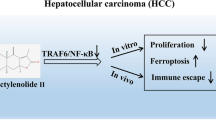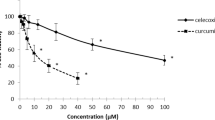Abstract
Cyclooxygenase-2 (COX-2) and ERK-MAPK mitogenic signaling pathways are important in human hepatocellular carcinoma. We investigated the effect of COX-2 inhibition on ERK-MAPK signaling and the effect of combining MEK (MAPK kinase) and COX-2 inhibitors in human hepatocellular carcinoma in vitro. COX and ERK expression were determined by immunoblot in HepG2 and Hep3B cells. COX-2 and MEK activity were determined by prostaglandin E2 assay and phosphospecific immunoblot, respectively. Cell growth was determined by cell proliferation and cell counts. Apoptosis was determined by DNA fragmentation enzyme-linked immunosorbent assay and flow cytometry. Cell cycle was determined by flow cytometry. HepG2 and Hep3B cells do not express COX-1 or COX-2. Correspondingly, basal and agonist (arachidonic acid, lipopolysaccharide)-stimulated COX-2 activity is undetectable. Treatment of HepG2 and Hep3B cells with NS398 resulted in an increase in ERK1/2 phosphorylation (MEK activity) in a concentration-dependent fashion (NS398, 1 to 100 μmol/L). Treatment with the COX-2 inhibitor NS398 in the presence of U0126 (MEK inhibitor) effectively suppressed ERK1/2 phosphorylation as determined by phosphospecific ERK1/2 immunoblot. Total ERK1/2 and COX-2 were unchanged with NS398 and U0126 treatments. In HepG2 cells, NS398 (1 to 100 μmol/L) decreased apoptosis as determined by DNA fragmentation enzyme-linked immunosorbent assay. Relative apoptosis was increased with U0126 alone or in combination with NS398 (9 to 10 times the control value), eliminating the anti-apoptotic effect of NS398. In Hep3B cells, apoptosis was unchanged with NS398 (1 to 50 μmol/L) or U0126 (1 to 10 μmol/L) alone. The combination of NS398 and U0126 in Hep3B cells resulted in a synergistic increase in apoptosis (10 times the control value). Relative apoptosis in both cell lines strongly correlated with changes in the expression of the antiapoptotic protein Bcl-xL. Cellular growth was assessed by colorimetric proliferation assay and cell counts. HepG2 and Hep3B cells had concentration-dependent inhibition of cell growth with NS398 or U0126 treatment alone. The combination of NS398 and U0126 resulted in complementary inhibitory effects on growth. Growth inhibitory effects in HepG2 and Hep3B cells with combination treatment appear to be, in part, secondary to the induction of G0/G1 and G2/M cell cycle arrest, respectively, as determined by flow cytometry. Despite differential signaling in HepG2 and Hep3B cells, the sum effect of combining the COX-2 inhibitor NS398 and the MEK inhibitor U0126 results in enhanced antitumor actions. This novel combination may be useful for in vivo studies of hepatocellular carcinoma.
Similar content being viewed by others
References
El-Serag HB, Mason AC. Rising incidence of hepatocellular carcinoma in the United States. N Engl J Med 1999;340:745–750.
Bae SH, Jung ES, Park YM, et al. Expression of cyclooxygenase-2 (COX-2) in hepatocellular carcinoma and growth inhibition of hepatoma cell lines by a COX-2 inhibitor, NS-398. Clin Cancer Res 2001;7:1410–1418.
Cheng J, Imanishi H, Amuro, Hada T. NS-398, a selective cyclooxygenase 2 inhibitor, inhibited cell growth and induced cell cycle arrest in human hepatocellular carcinoma cell lines. Int J Cancer 2002;99:755–761.
Kern MA, Schubert D, Sahi D, et al. Proapoptotic and antiproliferative potential of selective cyclooxygenase-2 inhibitors in human liver tumor cells. Hepatology 2002;36:885–894.
Denda A, Kitayama W, Murata A, et al. Increased expression of cyclooxygenase-2 protein during rat hepatocarcinogenesis caused by a choline-deficient, L-amino acid-defined diet and chemopreventative efficacy of a specific inhibitor, nimesulide. Carcinogenesis 2002;23:245–256.
Rice PL, Goldberg RJ, Ray EC, Driggers LJ, Ahnen DJ. Inhibition of extracellular signal regulated kinase 1/2 phosphorylation and induction of apoptosis by sulindac metabolites. Cancer Res 2001;61:1541–1547.
Brizuela L, Gyuris J, Mansuri M. Cyclin-dependent kinases and their regulators as potential targets for anticancer therapeutics. In Bronchud MH et al., eds. Principles of Molecular Oncology. Totowa, NJ: Humana Press, 2000, 197–203.
Takehara T, Liu X, Fujimoto J, et al. Expression and role of Bcl-xL in human hepatocellular carcinoma. Hepatology 2001; 34:55–61.
Scheid MP, Schubert KM, Duronio V. Regulation of BAD phosphorylation and association with Bcl-xL by the MAPK/ Erk kinase. J Biol Chem 1999;274:31108–31113.
FangX, Yu S, Eder A, et al. Regulation of BAD phosphorylation at serine 112 by the Ras-mitogen-activated protein kinase pathway. Oncogene 1999;18:6635–6640.
Deguchi M, Shiraki K, Inoue H, et al. Expression of survivin during liver regeneration. Biochem Biophys Res Commun 2002;297:59–64.
Author information
Authors and Affiliations
Corresponding author
Additional information
Supported by a grant from the Walther Oncology Center, Indianapolis, Indiana.
Rights and permissions
About this article
Cite this article
Schmidt, C.M., Wang, Y. & Wiesenauer, C. Novel combination of cyclooxygenase-2 and MEK inhibitors in human hepatocellular carcinoma provides a synergistic increase in apoptosis. J Gastrointest Surg 7, 1024–1033 (2003). https://doi.org/10.1016/j.gassur.2003.09.009
Issue Date:
DOI: https://doi.org/10.1016/j.gassur.2003.09.009




